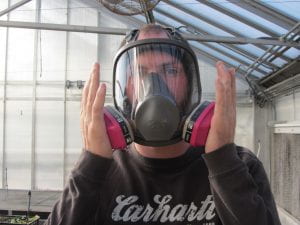 Do you or your employees make applications in enclosed places such as greenhouses or grain bins? Do you come into contact with harmful dusts, gases, vapors or mists? Then you may be required to wear a respirator!
Do you or your employees make applications in enclosed places such as greenhouses or grain bins? Do you come into contact with harmful dusts, gases, vapors or mists? Then you may be required to wear a respirator!
Why have respirator requirements changed under the Worker Protection Standard?
- To ensure that respirators are providing the intended protection
- Respirators may place a physiological burden on the wearer
- All other industries require these protections
Medical Evaluation
- Employees must provide a medical evaluation at no cost to the employee, prior to any respirator use
- Employee fills out standard OSHA questionnaire and may submit to a physician or licensed health care professional. Convenient online services are also available
- Medical clearance is only required once unless medical problems arise, or a fit test indicates a need for reevaluation
Fit Testing
- An annual fit test is required for all tight-fitting respirators where required by the pesticide label
- Must be completed after receiving a medical clearance
- Must be conducted with the same size, make, model and style of the respirator to be worn
- Includes particulate filtering face-piece respirators (dust/mist respirators)
Respirator Training
- Required annually or when workplace conditions change, or a new type of respirator is used
- How to inspect, use and perform seal checks
- Respirator maintenance and storage
- How to select cartridge/canisters and change out schedule
- How to recognize medical signs that limit effective use of respirators
- How to use respirators in emergency situations
Recordkeeping
- Records must be maintained for two years
- Name of employee
- Type of fit test performed
- Make, model and size of respirator
- Date and results of fit test
For more information on respirator requirements and fit testing locations in Ohio, see pested.osu.edu/wps/Respirator